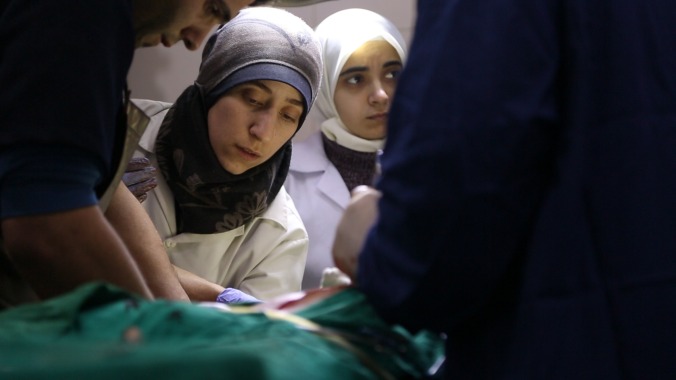Syrian war doc The Cave wants to be empowering, but it’s mostly just numbing

Feras Fayyad’s Oscar-nominated documentary Last Men In Aleppo succeeded through the power of its vérité footage. Fayyad captured the White Helmets’ search-and-rescue missions with stunning immediacy, highlighting the heroism of the volunteers, who spend their days digging people out of bombed-out rubble, while almost entirely eschewing mawkish sentimentality. But though it was a true portrait of courage, filmed in areas of extreme danger for Fayyad and his crew, Last Men In Aleppo did suffer from a certain shapelessness: It locked into a one-note rhythm—the bombing begins, the White Helmets run to the affected area, they save who they can, rinse and repeat—that undoubtedly reflects real life but also risked numbing audiences to the harrowing material. Fayyad’s project is objectively important, but his method of communicating the Syrian Civil War’s pervasive dread could be a liability.
Its limitations become impossible to ignore in Fayyad’s new companion film. The Cave follows physician Dr. Amani Ballour, who manages an underground hospital for victims of the conflict. Ostensibly a tribute to female solidarity, allowed to flourish literally below the surface of Syria’s hyper-patriarchal culture, it mostly communicates the disturbing reality of being an understaffed, under-resourced doctor operating in insalubrious conditions. Dr. Amani and her team are courageous figures, doing the Lord’s work for little-to-no reward, but Fayyad expresses this idea in one way: repeatedly showcasing the grievously wounded, and the doctors tending to them, in intimate detail. Early on, he establishes The Cave’s rhythm, similar to Last Men In Aleppo’s, and holds to it for the entirety of the film. Fayyad occasionally breaks things up with “light” scenes—the resident nurse trying to cook food in between bombardments; a makeshift birthday celebration—but these are mere pauses before the next wave of patients arrive. The Cave quickly devolves into a punishing affair that neither edifies nor compels. It just paralyzes you into submission.
Fayyad is obviously at the mercy of the footage his team shot between 2016 and 2018, which unflinchingly depicts the daily operations of the hospital. But the setting’s inherent claustrophobia combined with the repetitive nature of the work renders The Cave static, chaos becoming drudgery. Though he tries to build out Dr. Amani as a subject, her characterization is necessarily constrained by her dedication to the hospital and her powerlessness in the face of an oppressive regime. She’s a uniquely inspiring woman just by the very nature of her actions, but when she’s not tending to children or offering advice to her fellow doctors, the film often reduces her to an empowerment mouthpiece. Of course it’s infuriating when Dr. Amani faces everyday sexism in the workplace, especially in such acutely dire conditions, and her off-the-cuff comments about Syrian’s regressive culture are on point. Yet she remains anonymous because Fayyad defines her in such one-dimensionally idealistic terms. When he finally offers a brief glimpse of her outside this confining framework, expressing doubts about the efficacy of her efforts, it’s too little too late.
So what we’re left with is seemingly endless footage of severely injured civilians in utterly despairing circumstances. After the 40th or 50th image of a traumatized child suffering from broken limbs, gaping head wounds, or chemical burns, one might wonder about the effectiveness of such an approach, which amounts to rubbing an utterly helpless audience’s face in mud because it might be good for them. At some point, The Cave tips into morally questionable grotesquerie, a catalog of anguish that doesn’t spotlight anything except endless brutality. Dr. Amani and her team deserve commendation and respect for their tireless work, which often boils down to comforting people in extreme pain with nothing but words or music, but The Cave isn’t the best tribute to their actions. Instead, it’s a monotonous descent into agony that coasts on the impossibility of anyone walking away unaffected by the imagery.